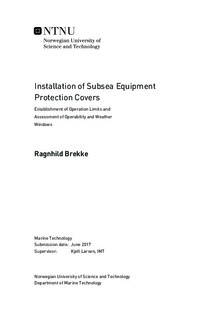| dc.description.abstract | The oil and gas industry has become more challenging the past years and marine operations must be performed in smarter and more cost-effective ways. Waiting on weather should be minimised and design and planning will be of high importance. A marine operation shall be designed to bring an object from one safe condition to another safe condition. A subsea lift consists of different phases that should be evaluated during the planning process, where the through splash zone phase is usually most critical. In order to account for uncertainty in weather forecast, the operation's design criterion is reduced by an alpha-factor.
Installations of protection covers are common offshore operations, but only a few hydrodynamic investigations have been performed on such objects. This Master Thesis describes a study aimed at finding as high operational criterion as possible for an installation of a GRP pipeline protection cover. Further investigations were performed on the differences in use of numerical simulations and DNV GL's Simplified Method. The operation's operability was investigated for the two different operational criteria.
For a light lift operation, the occurrence of slack in slings are critical and does usually determine the maximum operational sea state. Slack arises when the total hydrodynamic force acting on the object exceeds 90% of its submerged weight.
The lift was simulated for the splash zone phase in the non-linear time domain simulation program, SIMA. The minimum tension that arose in the slings for each wave condition with random seed number, were used to develop a Gumbel distribution. The sea state was categorised as operational if the 10% quantile, found by an inversed Gumbel CDF, was above the slack requirement.
The lifting system consisted of the vessel s crane tip, a crane wire, a hook, a hook winch, four slings, a spreader bar and the cover. The cover was implemented as slender elements in SIMA, were each slender element was given depth dependent added mass and drag. The implemented hydrodynamic parameters were estimated by CFD-analyses. The cover was lifted with an angle of 68 degrees, and the short-term environmental conditions were characterised by short-crested JONSWAP wave spectra.
The installation was defined as a weather restricted level B marine operation. The total hydrodynamic force was manually estimated by the Simplified Method. The respective added mass and drag were calculated by use of tabulated coefficients for rectangular flat plates, in two directions; longitudinal and perpendicular to the cover flanges. The total added mass for a rotated cover was found by summing the vertical components of the longitudinal and perpendicular added mass. The largest tension variations occurred right after the cover was fully submerged, hence slamming and varying buoyancy forces could be omitted. The inertia and drag forces were dependent on the most probable largest crane tip motion, found by the crane tip and vessel COG locations. The maximum sea state was assessed by use of linear scaling. The average manually estimated design criterion was 1.64 m and constant for all peak periods. Hence with an alpha-factor of 0.76 the operational criterion was 1.25 m.
For each wave condition, 20-30 lowering simulations were performed with random seed numbers. The average winch speed was 0.2 m/s and the cover was lowered to a depth of approximately 33 m. Both the spreader bar and the cover experienced large motions in air. The motions diminished when the cover entered the water. The tension variation in the lifting system increased when the cover entered the splash zone and calmed down when the cover was lowered to 20 meter depth.
The simulated design criteria were found by investigating the tension in the lifting slings. No large snap forces were observed after a slack condition. The simulated design criteria were dependent on both significant wave heights and peak periods. The average design criterion was independent of peak periods and determined to be 2.5 m. Hence with an alpha-factor of 0.81 the operational criterion was 2 m.
The operation can take place if the wave conditions are below the operational criteria over a longer duration than the operation's reference period. The operability was investigated for two fields; Heidrun and Tanzania Block 2. The reference periods were dependent on the water depth, and thus determined to be 2.5 hours and 9.3 hours for the two fields respectively. The operability and actual duration of operation with a random start were heavily season dependent, and were studied for both the manually estimated and simulated operational criteria.
When the operational criterion increased from 1.25 m to 2 m the operability increased with 30-50% at both fields. At the same time the actual duration of operation with a random start decreased with up to 80% at Heidrun. That is, for a given reference period, the waiting on weather decreased with the corresponding. Generally, at both fields the reason of waiting on weather was due to storm periods, where the wave conditions were above the operational criterion.
The operational limit was determined by several factors; the installation method, the environmental conditions, the crane tip motion, the alpha-factor and the tension airing in the slings. According to this one can say that an operation should be short in order to be able to take place often. For increased operational criteria the operability increased and waiting on weather decreased.
If the operation should take place at a random time, the risk of waiting on weather will increase. Usually, a marine operation is planned ahead of execution and is based on weather forecasts. Such planning will with a high probability reduce waiting on weather and increase the operation efficiency.
In order to determine the highest operational sea state as possible in such a way that waiting on weather can be reduced, simulations should be performed prior to installations of pipeline protection covers. Hence operational costs, engine idling and pollution can be significantly reduced compared to only relying on the simplified method. | |

